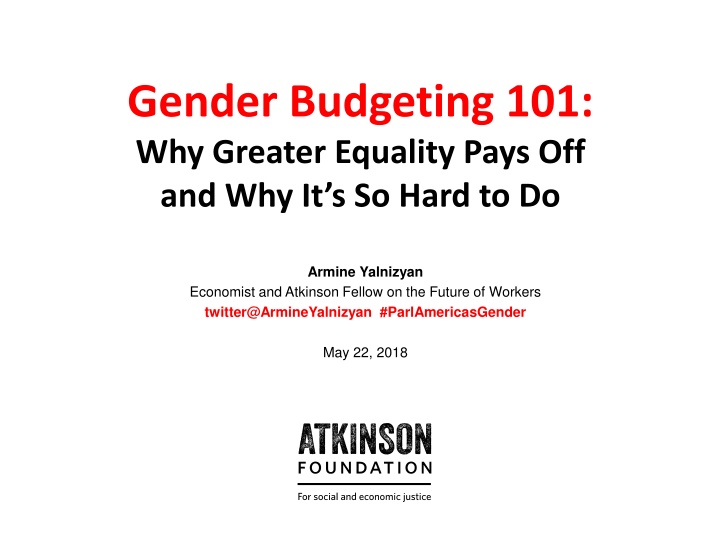
Unveiling the Power of Gender Budgeting for Economic Equality
Delve into the transformative impact of gender budgeting on achieving greater economic equality. Explore the challenges and benefits associated with this approach, as well as its intersection with climate action and social progress. Discover why practicing gender budgeting is key for fostering political accountability and driving optimal resource allocation. Learn about the global adoption of gender budgeting practices and their profound implications for society and the economy.
Download Presentation

Please find below an Image/Link to download the presentation.
The content on the website is provided AS IS for your information and personal use only. It may not be sold, licensed, or shared on other websites without obtaining consent from the author. If you encounter any issues during the download, it is possible that the publisher has removed the file from their server.
You are allowed to download the files provided on this website for personal or commercial use, subject to the condition that they are used lawfully. All files are the property of their respective owners.
The content on the website is provided AS IS for your information and personal use only. It may not be sold, licensed, or shared on other websites without obtaining consent from the author.
E N D
Presentation Transcript
Gender Budgeting 101: Why Greater Equality Pays Off and Why It s So Hard to Do Armine Yalnizyan Economist and Atkinson Fellow on the Future of Workers twitter@ArmineYalnizyan #ParlAmericasGender May 22, 2018
The New Abnormal: Slowth #ParlAmericasGender
Causes of Slowth Population Aging Geopolitical Uncertainty Income Inequality Climate Chaos #ParlAmericasGender
Types of Climate Action Offset trends Mitigate damage Improve speed of adaptation Gender Responsive Budgeting (GRB) facilitates all three strategies #ParlAmericasGender
Intersection of Climate Action and Gender Budgeting Pivot from dirty to clean energy sources (reduces carbon emissions) Energy Water Health Care Housing Transit Improve access to clean water, energy, etc (frees up paid/unpaid productive time) Prevent preventable disease/death Reduce volatility in individual lives, economy-wide growth Improved Public Infrastructure Is a Women s Issue #ParlAmericasGender
The Big Picture Improve access to basic infrastructure, change the trajectory of women s lives Change the trajectory of women s lives, improve social and economic outcomes #ParlAmericasGender
Beyond Climate Action: Why Practice Gender Budgeting? Economic optimization Growth from better resource allocation (L, K, tech) Social efficiencies Better use of paid and unpaid labour, lower risk by broadening access to basics Fiscal improvements Higher revenues, lower costs, less inequitable results Greater Political Accountability Ex ante target setting, ex post review, better data #ParlAmericasGender
Who Practices Gender Budgeting? OECD 2016 survey: 12 nations (plus 1) Austria, Belgium, Finland, Iceland, Israel, Japan, Korea, Mexico, Netherlands, Norway, Spain, Sweden .since 2017 Canada IMF survey: 23 nations, mostly non-OECD Australia, India, Philippines, Bangladesh, Rep. of Korea, Albania, Macedonia, Ukraine, Morocco, Afghanistan, Timor, Leste, Rwanda, Uganda, Mexico, Ecuador, Bolivia, El Salvador #ParlAmericasGender
How To Do Gender Budgeting? Ex Ante Establish baseline: who gets what? Needs assessment: what s missing in the status quo? Develop strategy: targets/timelines, resources Indicators to change Rates of violence against women Access to Utilities (water, fuel/energy, telcom) Health/education outcomes % Budget on Housing, Child Care, Education, tax exps Labour Force Participation Rates; Wage Gap Expand Social Security (% with pensions, jobless benefits) #ParlAmericasGender
How To Do Gender Budgeting? Ex Post Course correct budgetary resource allocations to achieve performance goals Review and assess incidence of budgetary measures (tax and spend) Within Finance, outside of Finance (government/opposition); gender audit Separate gendered analysis/documents or built into budget (review outcomes from previous budgets; progress on targets/timelines) #ParlAmericasGender
How To Talk About Budgets Costs vs Benefits of Federal Spending Women use *and* provide more public services BUT It s easier to calculate costs of spending than benefits Focus on taxes/tax cuts is about who pays ( winners and losers ) disconnected from what is being paid for It s harder to measure both benefits of services provision and impacts of service loss (what is relevant time frame; distribution of impacts by age, gender, incomes; direct/indirect benefits) #ParlAmericasGender
Who Benefits From Spending? More Low Income Households (Women) Vermaeten: Fed spending on housing in 1994 was highly redistributive, measured by $ or by % of income #ParlAmericasGender
Who Benefits From Spending? More Low Income Households (Women) CCPA: Government services in 2006 were worth over two times as much as the incomes of the poorest Canadian households #ParlAmericasGender
Who Benefits From Tax Cuts? More High Income Individuals (Men) Policy priority in past 25 years: More Money In Your Pockets Who Do Services Reach? From what we know by age, gender and income, typically women are more reliant on public services Long-form Census is one source of data Administrative data (ex. health care, education, social housing) Only Census provides race, immigration status data Who Do Tax Cuts Reach? As of 2017 final tax statistics (2015 incomes) 27.0% of men did not have taxable income 37.4% of women did not have taxable income Since 2008, data on income class plus gender no longer published #ParlAmericasGender
GRB offers a radically different approach to budgeting Current Focus: on costs Focus on budget balance/deficits ACCOUNTING FRAMEWORK Irony: measures that save money end up costing more (health care, prisons, police, justice) GRB Focus: on benefits Focus on improving benchmarks associated with greater well-being HEALTH/QoL FRAMEWORK Irony: measures that require more spending can end up saving more (less health care, jobless benefits, prisons, etc.) You reap what you sow #ParlAmericasGender
GRB offers transformative outcomes from budgeting System-based, not departmental Outcome-oriented, not spending. The focus is on monitoring performance to achieve targets Links costs to benefits Like population health interventions: improves system health by reducing inequities Like population health research: we re in the early stages of learning how to improve measures of benefits/outcomes (fiscal year? 5 years? Lifecycle?) #ParlAmericasGender
What Do You Need To Do GRB? Ability to track past program spending Public Accounts, Tax Expenditures Ability to model costs/benefits of future proposals Access to Data Interest of government/opposition Resources: no $, no strategy #ParlAmericasGender
How Much $ Buys Change? Size Matters, but... It s not how big it is; it s how you use it #ParlAmericasGender
Gender Budgeting 101 Takeaways Within context of slowth and increasingly fractious politics, distributional considerations in budgets matter more than ever Budget measures that tackle gender inequality are rapidly becoming more politically acceptable/popular Gender budgeting can improve economic performance, political accountability, and social outcomes Such results are unlikely to occur without more public spending, but how you spend is as important as how much you spend #ParlAmericasGender
Thank you for your time and your commitment to change #ParlAmericasGender



















